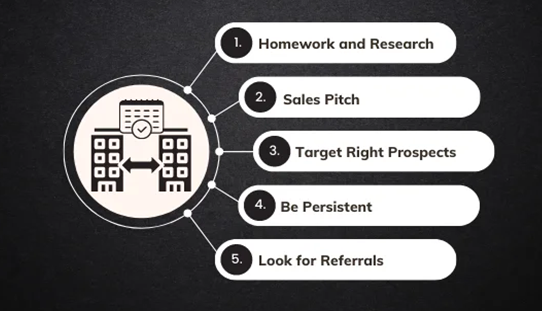Appointment-setting streamlines the B2B lead generation process by assigning specific reps to research and nurture prospects before scheduling appointments. In this guide, we'll explore the importance of the B2B appointment-setting process, the challenges involved, and the key skills an appointment-setter needs.
What Is B2B Appointment-Setting?
B2B appointment-setting is the process of scheduling an official meeting between a qualified lead and a closing sales rep.
Appointment-setters (also called sales development reps, or SDRs) go through contact lists and conduct research on prospective customers before reaching out to them and pitching the company's product or service. The SDR then screens prospects based on a list of criteria and starts to build a rapport with them.
Once a lead has been qualified and nurtured, SDRs determine the best time to schedule an appointment. Then they pass the details to closing sales reps, who provide more detailed information and make the final sale.
Why Is an Appointment-Setting Process Important?
Appointment-setting helps sales teams focus their time and effort on buyers who are actually interested. Instead of repeatedly calling leads in the hope of catching them, it's more efficient to call at an agreed, scheduled time.
Appointment-setting enables you to split lead generation into phases, and it allows for sales specialization: Some reps are best suited to prospecting and appointment-setting, whereas others are skilled at closing. Specialization shortens the sales cycle and increases sales and revenue.
Ultimately, B2B appointment-setting helps you to deliver a better customer experience. It provides an opportunity for sales teams to get to know prospective clients and form lasting relationships, as well as establish brand awareness.

Source: GrowthRhino
Challenges in B2B Appointment-Setting
Appointment-setting is not an easy task, even for experienced sales reps. Here are some of the hurdles you might encounter.
1. It's time-consuming
Appointment-setting is an ongoing strategy that requires daily activity. You have to put in a lot of hours (which is why some companies choose to outsource the process). If you don't keep up that connection with prospects in the sales pipeline, you won't get results.
2. It can be frustrating
Appointment-setters hear plenty of objections, and it's all too easy to get demotivated and move on to the next prospect.
Another issue is that without the right research, reps can waste time on talking to the wrong person at an organization—someone who has no decision-making power.
3. It requires smart tools
B2B appointment-setters might contact more than 100 prospects a day on multiple channels, so it's vital to stay organized. Without the right tools in place, reps won't be able to keep track of their accounts and conversations. Consider syncing your CRM and outreach tools with something like the Constant Contact Salesforce integration.
What Makes a Good Appointment-Setter
A sales agent needs key skills to overcome the challenges of appointment-setting. Here are some of the most important.
1. Great communication
Appointment-setters must be natural communicators with excellent interpersonal skills, confident in talking to executive-level decision-makers and building trust.
They listen to needs and concerns and show them how the company's product or service can help, being persuasive without being pushy. Plus, they must communicate all the information to closing reps once an appointment has been scheduled.

Source: McKinsey & Company
2. Understanding of the product
It's essential for appointment-setters and SDRs to have a sound understanding of the company's product or service so they can explain its features and value to prospects. Let's say your company sells Shopify ERP solutions. SDRs need to show why yours are the best on the market, using statistics and reviews rather than vague statements.
3. Problem-solving
SDRs have to be able to handle objections effectively and not get demoralized. They need to think of objections as an opportunity to learn more about the prospect's frustrations.
That means being adaptable with a sales pitch, using experience to answer unexpected questions, and providing more detail if necessary.
4. Multichannel familiarity
Appointment-setters need the ability to interact on whichever channel is most convenient for the prospect. That means being familiar with multiple channels, from phone and email to social media, and being able to hop around among them—and keeping accurate records. It also means having the right communication tools to do so.
5. Timing
Part of the nurturing process involves learning about prospects' schedules so you can reach them at the most convenient times. You don't want to call when they've left for the night and get their auto attendant instead. And once you've scheduled a call or an appointment, it's vital that you stick to the plan.
Stages of B2B Appointment-Setting
Now let's look at the five stages of appointment setting—and how to get them right.
1. Research
Using a contact list, conduct online research on all potential leads and select the businesses that fit your company's target audience. Identify the key decision-maker at each organization so you'll be talking directly to someone with buying power.
2. Reach out
Contact those leads, introduce your company and product, and gather information about the prospect with thoughtful questions. That process will enable you to personalize subsequent interactions. Some companies use automated tools for dialing numbers or sending initial messages.

Source: Crunchbase
3. Nurture
You're not going to set an appointment on the first call. You need to build a relationship through regular, personalized interactions, showing prospects that you care about solving their problems. And if prospects call you, technology such as interactive voice response can ensure they're directed straight to you.
4. Schedule
When you schedule an appointment, maximize efficiency by knowing the closing rep's availability in advance. It's helpful to use a Cloud-based digital calendar that the entire team can access from anywhere. It will automatically send invitations to the prospect and the closing rep, so they can confirm.
5. Evaluate
It's worth assessing the success of the appointment-setting phase and refining your strategies if needed. Take feedback from reps and prospects: How did they get on with the scheduling software? What product information was requested? Did closing reps need more details about potential clients?
* * *
Appointment-setting is an essential part of the B2B sales cycle. If you choose reps with the right skills for the role and address the potential challenges with training and smart software, you'll move leads along the sales funnel much faster and ensure that closing reps are talking only to prospects with a genuine intention to buy.
More Resources on Sales Appointment-Setting
Sales Meeting No-Shows: It's Not You, It's Them (And What You Should Do Next)
How to Create Response-Boosting Cold Emails
Don't Be a Lead Killer: Three Ways to Keep Sales Leads Alive




